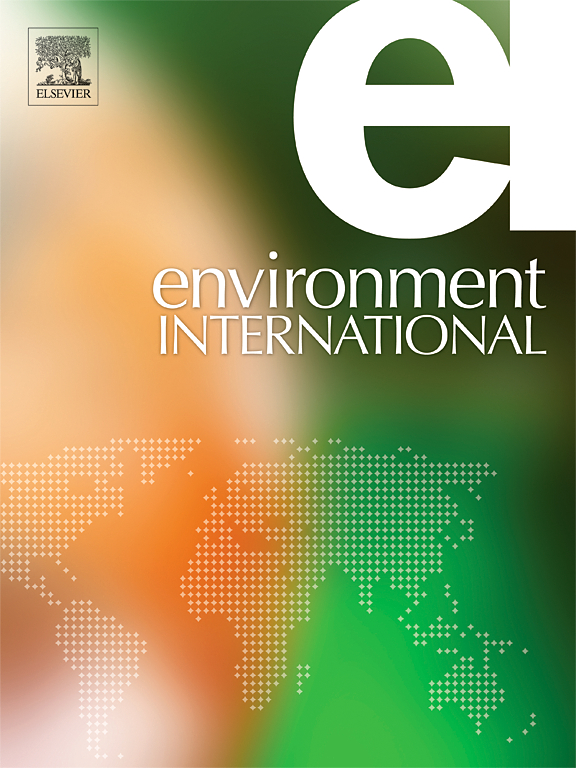数据驱动的抗生素混合物对革兰氏阴性和革兰氏阳性细菌的风险评估:QSAR,联合毒性作用和成分贡献
IF 10.3
1区 环境科学与生态学
Q1 ENVIRONMENTAL SCIENCES
引用次数: 0
摘要
由于气候变化下的流行病爆发,抗生素的需求和使用不断增加,导致更多的抗菌物质进入环境。残留药物通常以混合物形式存在,可专门针对细菌,对生态系统和人体健康构成威胁。因此,有必要以细菌作为模式生物来评估抗生素混合物的风险。本研究以磺胺类、磺胺类增强剂和四环素类抗生素为代表,分别对革兰氏阳性菌(枯草芽孢杆菌)和革兰氏阴性菌(费氏alivibrio fischeri和大肠杆菌)进行了单独和联合毒性试验。以Ebind(抗生素与靶蛋白之间的最低相互作用能)和Kow(辛醇-水分配系数)为结构描述符,构建了定量构效关系模型,为预测单药和二元混合物的毒性提供了可靠和稳健的工具。在革兰氏阴性菌中观察到低剂量刺激和高剂量抑制的致敏效应,革兰氏阳性菌的剂量反应均呈s型。在抗生素混合物的激效现象中,联合毒性作用和成分贡献的模式通常随着刺激作用向抑制作用的转变而改变。这些结果不仅证明了细菌种类和试验终点对抗生素毒性的影响,而且阐明了激效在抗生素联合作用中的关键作用。本研究提供了一种数据驱动的混合物联合毒性评估方法,将促进抗生素与其他环境污染物风险评估的发展。本文章由计算机程序翻译,如有差异,请以英文原文为准。


Data-driven risk assessment of antibiotic mixtures against gram-negative and gram-positive bacteria: QSAR, joint toxic action, and component contribution
The increasing demand and use of antibiotics due to epidemic outbreaks under climate change leads to more antibacterial substances entering the environment. The residual drugs, commonly found as mixtures, can specially target bacteria, posing a threat to the ecosystem and human health. Therefore, it is necessary to assess the risk of antibiotic mixtures using bacteria as the model organisms. In this study, selecting sulfonamides, sulfonamides potentiators, and tetracyclines as the representative antibiotics, the individual and combined toxicity of these agents were tested against Gram-positive (Bacillus subtilis) and Gram-negative bacteria (Aliivibrio fischeri and Escherichia coli). The quantitative structure–activity relationship models were constructed by setting Ebind (lowest interaction energy between antibiotic and target protein) and Kow (octanol–water partition coefficient) as the structural descriptors, which provide reliable and robust tools for predicting the toxicity of single agents and binary mixtures. Furthermore, the hormetic effects, characterized by low-dose stimulation and high-dose inhibition, were observed in Gram-negative bacteria, and the dose-responses in Gram-positive bacteria all exhibited S-shaped. Within the hormetic phenomena of antibiotic mixtures, the pattern of joint toxic action and component contribution generally changed with the transition from stimulatory to inhibitory actions. These results not only demonstrate the influence of bacterial species and test endpoints on the toxicity of antibiotics, but also clarify the pivotal role of hormesis in the joint effects of antibiotics. This study provides a data-driven methodology for evaluating the combined toxicity of mixtures, which will promote the development of the risk assessment of antibiotics and other environmental pollutants.
求助全文
通过发布文献求助,成功后即可免费获取论文全文。
去求助
来源期刊

Environment International
环境科学-环境科学
CiteScore
21.90
自引率
3.40%
发文量
734
审稿时长
2.8 months
期刊介绍:
Environmental Health publishes manuscripts focusing on critical aspects of environmental and occupational medicine, including studies in toxicology and epidemiology, to illuminate the human health implications of exposure to environmental hazards. The journal adopts an open-access model and practices open peer review.
It caters to scientists and practitioners across all environmental science domains, directly or indirectly impacting human health and well-being. With a commitment to enhancing the prevention of environmentally-related health risks, Environmental Health serves as a public health journal for the community and scientists engaged in matters of public health significance concerning the environment.
 求助内容:
求助内容: 应助结果提醒方式:
应助结果提醒方式:


